A Big Mission for a Small Country
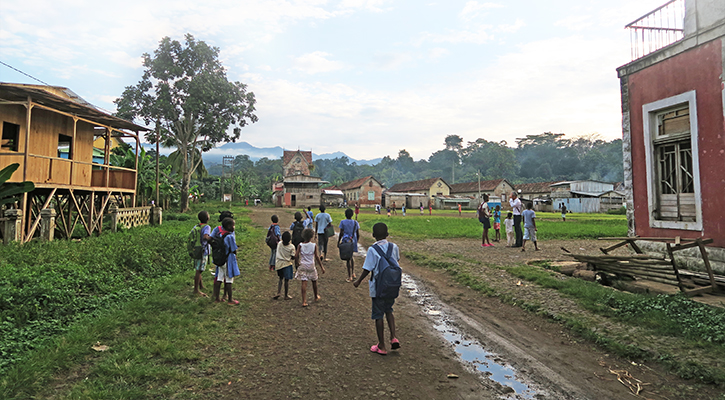 It is almost sunset in São Tomé and Príncipe, a small country located 150 miles off the western equatorial coast of central Africa. A Maranatha team is visiting churches in this little known country, and today, we are driving toward a neighborhood just outside of São Tomé, the capital.
It is almost sunset in São Tomé and Príncipe, a small country located 150 miles off the western equatorial coast of central Africa. A Maranatha team is visiting churches in this little known country, and today, we are driving toward a neighborhood just outside of São Tomé, the capital.
The road takes us away from the city and into the rainforest. After about 25 minutes, a left turn takes us onto a gravel road that opens into a wide area. Fog-covered mountains hug the edges of the valley. In one section, there are old brick buildings, organized in rows. Smaller houses dot the perimeter. Toward the center, there is a crumbling mansion. The scene is breathtakingly beautiful yet haunting because of the history it represents and the harsh reality it reveals today.
This entire property was once a plantation, and now serves as a remnant of the days when São Tomé and Príncipe was under Portuguese rule, and cocoa was the country’s gold. There are similar plantations all over São Tomé; they are a testament to the nation’s long past with colonialism and slavery. Forty years after they gained independence, the cocoa industry has dwindled, and São Tomé and Príncipe’s economy is suffering.
More than 50% of the country’s 200,000 residents live below the poverty line. Food availability is inconsistent, leading to malnutrition. The government is struggling with debt and relies heavily on foreign aid. In the meantime, a steadily growing population is putting pressure on available resources.
So today, most of the grand plantations have lost their stateliness, and they are occupied by renters and squatters.
Just 100 yards from the old mansion, there is another large building. It too was built by plantation owners from the past. People live in the building, as evidenced by the laundry hanging outside the windows and children playing outside. Underneath the main structure, there is a dark, stuffy basement. From here, music emanates. People are singing and praying and worshipping.
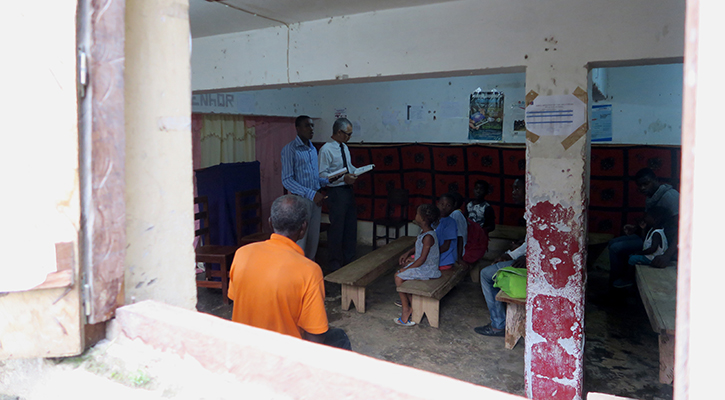
The Boa Entrada congregation worships in their basement church. The space is dark, hot, and stuffy. The rent is about $50 for six months—an amount that is a financial burden for the young group.
This basement is a church.
The Boa Entrada Seventh-day Adventist congregation has been meeting in this dank, mosquito-ridden space for six years. It is too small for the nearly 100 people who meet here every Sabbath. At $8 a month for rent, it is too expensive for these members. An estimated 85% of the Adventist population in the country are young people; most of them cannot find work and are unemployed. It is also a terrible space for outreach.
‘Some members have told me they are ashamed because they are not able to welcome visitors,’ says Luiz Almeida, a district pastor for the Praia Loxinga district. ‘It is too hot. The first time I visited this congregation, I felt sick [from the heat].’
Boa Entrada is one of 11 congregations that Almeida oversees. Only three have proper places of worship; eight groups meet in peculiar, borrowed spaces. He says Boa Entrada is one of the worst situations he has ever seen. But based on the churches that Maranatha has visited in São Tomé, Boa Entrada’s contemporaries are not far ahead. Most of them are pitiful structures. All of them need more space.
‘The Adventist church in São Tomé can potentially grow. People easily accept the Gospel,’ says Almeida. ‘The Gospel can reach many people here.’
The problem is they need real churches.
In the Beginning
The Adventist church in São Tomé and Príncipe has already experienced tremendous growth in recent history.
According to the local Adventist leadership, the message first came to São Tomé and Príncipe in 1936 through the work of a colporteur named Jose Frei. Initial interest in the Gospel brought Frei back in 1938. From then on, missionary pastors from Portugal arrived in São Tomé, every three years, until 1974.
In 1975, the country gained independence from centuries of Portugal’s colonization. Up until this time, leaders estimate that there were only 500 members in the Adventist church in São Tomé and Príncipe. Then, during the new phase of government, the church underwent some challenges. The leadership nationalized all the schools in the country, banning private education. The Adventists lost their school. Disagreements led to a split in the church. Growth during this time period was slow to non-existent.
It wasn’t until the early 1990s, when the government began moving toward democratic reforms, that the church began to grow.
Today, there are officially more than 7,000 Adventists in São Tomé and Príncipe, although locals say the number is close to 8,000. They make up 70 groups and congregations meeting in the country. Yet only 20 have permanent places of worship. The rest—all 50—are meeting in borrowed spaces.
‘The church members are missionaries and active. Because of that, the church has grown in number of members, but the facilities have not grown proportionally. It is one of the challenges faced by the Adventist Church,’ says Fernando Melo, president of the Adventist Church in São Tomé and Príncipe.
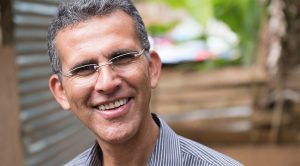 The lack of infrastructure is a looming threat to the progress the church has made in the past few decades.
The lack of infrastructure is a looming threat to the progress the church has made in the past few decades.
‘No more members can join these groups,’ says Melo. ‘We need to expand the congregations, which have already been established. Congregations don’t have a chance to grow because of their poor physical space and because they don’t look like a real church.’
Houses of Worship
Melo’s assessment is correct in that few of the worship spaces that Maranatha visited look like an actual church. One group rents a former disco club, where the remains of an old bar still stand. A congregation meets in a scrap metal box on the side of the road. Yet another group meets under a tarp in the front patio of a woman’s home.
The Agua Marçal church, located in the city of São Tomé, is one of the more unusual structures. It is a two-story building with basic framing and a roof. There are no walls and no floor.
Eleven years ago, this skeleton was the beginning of a family home for Manuel Frota. He had been living in his mother’s home and planned to build a house next door. But not long after he started the project, the construction materials were stolen, and Frota’s meager wages as a shoe cobbler could not afford him more wood. He gave up on the project.
A couple years later, Frota’s church, Boa Morte Adventist Church, asked him to host Bible studies on his property.
‘It started as a small group. We invited people to study. And then we had a service and prayed. Others showed up. Neighbors came, and the group grew,’ says Frota.
He invited his small group to join Boa Morte. But with all the outreach, the congregation grew so large that they could no longer fit into the church. As a solution, church leaders asked Frota to start a separate group at his property.
Now, there are 70 baptized members and many visitors worshipping at Frota’s church, which was named Agua Marçal. On average 140 people gather at this unfinished structure every Sabbath; half of them have to sit outside.
‘We have some issues because the space is small. We need to expand the place,’ says Frota.
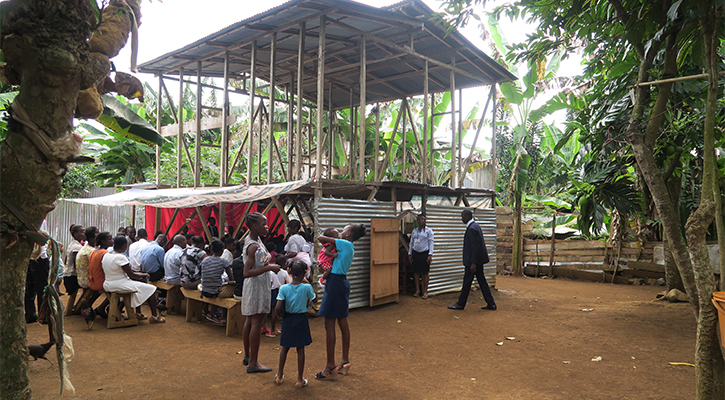
Members spill out from the skeletal structure that is the Agua Marçal church. On some Sabbaths, the 70-member congregation will double in size because of visitors and children.
Space isn’t the only issue.
‘When the dry season comes, the place gets full of dust. The movement of a large number of people raises the dust, causing serious health conditions,’ says Francisco Bonfim, pastor of the Agua Marçal church. ‘When the rainy season comes, we have difficulties, too.’
Despite the challenges, Bonfim is grateful to Frota for his hospitality. But everyone knows that Agua Marçal needs a change.
‘It is not ideal to have the service at a member’s home because then they do not have privacy. Some people do not come here because they feel uncomfortable attending a church settled at somebody else’s place,’ says Bonfim.
As for Frota, he’s still living in his mother’s home with his wife and daughter. The hope of finishing his house is still alive, but until Agua Marçal finds an actual temple, the dream has to be put on hold.
‘One day we will construct a temple, hopefully,’ he says. ‘We’ll have the meetings here until the day we have a temple.’
Calling Maranatha
The prayer for a temple is a loud one, coming from all corners of São Tomé.
‘This is the most important request people make,’ says Melo. ‘[The people we invite] say, ‘If a congregation had a temple, they would go.’ We need temples to settle in people properly, attract those who would not go to someone’s house—only a temple. Moreover, temples help to expand the presence of the church where there are no Adventist congregations.’
A few years ago, Adventist leadership in São Tomé and Príncipe contacted Maranatha, asking for assistance in the construction of churches. They also requested help in expanding their recently constructed Adventist school. After years of discussion and research, Maranatha committed to working in São Tomé in 2017.
‘Those who want to be part of this project will not only help to build temples, they will also build a history of transformation in this community,’ say Melo. ‘We need temples in São Tomé. Temples that represent the Gospel message 24/7. Temples that can help to attract and save people through the Gospel of Jesus Christ.’
As with any Maranatha project, the challenge will be raising enough funds for the projects. The Adventist Church in São Tomé and Príncipe has identified property for several churches, and Melo’s team has started purchasing land. The process is never easy for any of the areas where Maranatha works, and it is a tremendous financial challenge for the Adventists in São Tomé, where many of the members are impoverished. As an example, only 20% of the membership own Bibles; the rest cannot afford one.
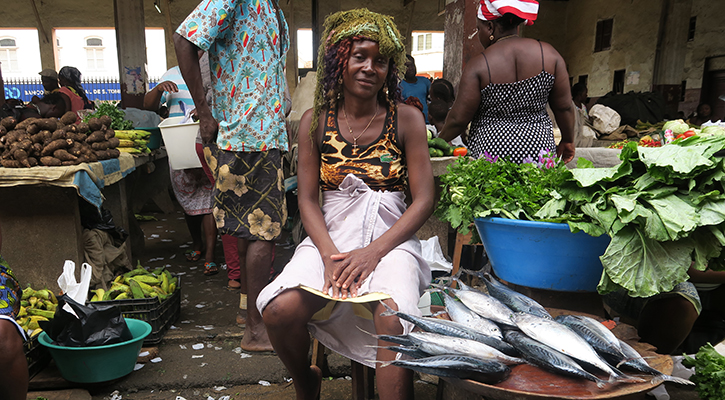
A woman waits for a customer in downtown São Tomé. While fish and fruit seem abundant on the island, studies have shown that a significant percentage of children are malnourished, and much of the country’s food has to be imported.
Now, Maranatha is actively fundraising for projects in São Tomé. Given its isolated location and scarcity of resources on the island, construction materials will be expensive. But Melo is hopeful that people will be touched by the plight of São Tomé’s people. Melo himself is a missionary from Brazil, and he has been in the country for a little more than a year. In that time, he has witnessed the difficulties of a life lived in poverty and the strength of a hope found in Jesus Christ. Life in São Tomé has dramatically changed his priorities.
‘I realized how people, residents from other places, spend much money on frivolities, while people here live under such basic conditions. I think the money I spent in the past could have helped people here. I think about how much money my friends have in contrast to the people here, who have so little,’ says Melo.
‘Every time I have a chance to talk with friends [back home], church members, and those who love God and the Gospel mission, I share the experience of being here [in São Tomé],’ he says. ‘I have seen many needs and challenges, but I believe the challenges are smaller than God’s blessings.’
Starting in January 2018, volunteers will head over for multiple mission trips to build churches. Projects will also include the construction of school classrooms at the Adventist school in São Tomé. It is the only Adventist school in the country, and it took 11 years for the church to save and build a small campus, which accommodates students in preschool through third grade. A couple years into operation, the school has earned a solid reputation, and parents are asking for more grade levels. Yet construction funds are scarce, and the government is threatening to seize land that is not occupied by classrooms. Time is ticking on the property, and Maranatha will help by building eight classrooms.
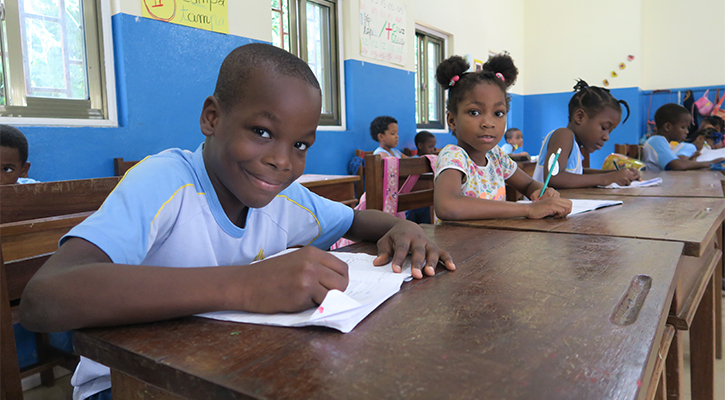
Children study at the local Adventist school. There is only one Adventist school in the country, and it offers limited grade levels. They have requested Maranatha’s help in expanding the school.
Considering São Tomé and Príncipe is Africa’s second smallest country and only about one-third the size of the state of Rhode Island, it seems like a big project for such a tiny country. But São Tomé and Príncipe has a big heart and a big mission. The membership is working hard to share the Gospel, using every resource and every space they have to welcome people into their faith community. All they need now is a bit of help with construction.
‘I pray for those who feel touched by [our story]. It does not matter how big your donation is—it will make a difference,’ says Almeida. ‘Open your heart and let God use you for Him. It will help the church, the ministry, and the mission. We have to make disciples to all nations, and now we have to make disciples in São Tomé.’
Volunteer Opportunity to Sao Tome
